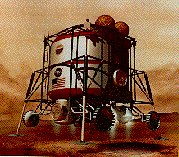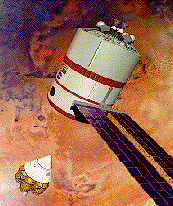
The logistics of a crewed mission to Mars are complex to say the least. Not only must the engineering problems be addressed, but the philosophical issues pertaining to our interference with the natural evolution of another planet must also be resolved (especially if extant Martian life is discovered).
There are three categories of risk environments in such a mission:

Approximately every 26 months, Mars and Earth are at their closest together. During 4 of these "launch windows," several launches will be performed - some sending supplies and some sending astronauts - to Mars.
Conventional chemical rockets will be used to launch Mars-bound spacecraft into low Earth orbit (LEO). A liquid hydrogen nuclear thermal rocket (NTR) will be used to transfer the vehicles from LEO to Mars. The NTRs use about 1/2 as much fuel as conventional chemical rockets. The technology for the NTR was developed to near-flight status in the 1960's.
In 2018, 3 launches will be performed. The first will send a fully fueled Earth return vehicle (ERV) into Martian orbit. The ERV will return the crew to Earth and splash down like the old manned missions from the 1960's. The second launch will send to the surface of Mars an unfueled Mars ascent vehicle (MAV), a liquid oxygen/methane propellant production module, a 160 kW nuclear power module, a supply of liquid hydrogen, a utility truck and a pressurized rover. The third launch will send to the surface of Mars a surface laboratory, a second 160 kW nuclear power module, a utility truck, tools, and spare parts. The surface laboratory will contain the food supplies for the crew.
In 2020, there will be 3 launches. The first will send a second fully fueled ERV to Martian orbit (there will be a good deal of redundance in the systems, of course). The second launch will send a second unfueled MAV, spare parts and such to the Martian surface. The third launch will be the first crewed vehicle to Mars! The travel time to Mars will be about 180 days. The crew will be at Mars for 500-600 days. The first crew will likely consist of 6 or 7 individuals with a diversity of expertise (engineering, medicine, geology, social science).
In 2022 and 2025, there will be 3 launches similar to the situation in 2020. This will mean 12 launches from Earth, 3 of them crewed, and a mission lasting a total of 9 years.
 |
 |
Once at Mars, an aerocapture manuever will be used by both arriving cargo and crew modules to enter Mars orbit. This saves both spacecraft mass and fuel. The descending modules will then use their aeroshells to enter the Martian atmosphere and will slow for landing using either parachutes or rockets. Soon after landing, the crew will position the crew and laboratory modules next to one another and the two modules will be connected.

The pressurized surface rover will be capable of long duration surface expeditions, possible up to weeks at a time.


The astronauts will study the geology and mineralogy of the surrounding area and will search for evidence of life, either past or present.


At the end of their 16 to 18 month stay on the surface, the crew will climb aboard the Mars ascent vehicle (MAV) in mid 2022. The MAV is a single stage launch vehicle that is designed for the short filght from the surface to the orbiting Earth return vehicle (ERV).


Go to Section 11 - Observing Mars this Year (1999 version).